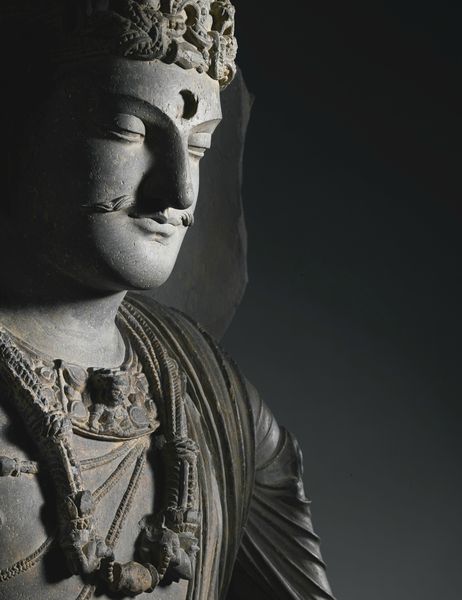A Grey Schist Standing Bodhisattva, Ancient region of Gandhara, Kushan period, 3rd-4th century
A Grey Schist Standing Bodhisattva, Height: 57 3/4 in. (148 cm). Ancient region of Gandhara, Kushan period, 3rd-4th century. Photo: Sotheby's.
PROVENANCE: Acquired in Turin, Italy in 1977
Private Italian Collection
This exquisitely carved standing bodhisattva is a superlative example of the Gandharan style of monumental sculpture that flourished in the northwestern part of the Indian subcontinent from the 1st–5th centuries CE.
NOTE: Standing erect with serene expression, his powerful torso enrobed in an elegantly draped sanghati or mantle, the bodhisattva manifests a regal countenance. The abundance of highly elaborate jewelry, representing the spiritual riches of thebodhisattva, is extraordinary in its minute details: the crown element with removable dovetail mortise and tenon; the cascading tresses of hair; the large urna cavity which once would have held a precious stone; the highly decorative lion earring in the left ear; the female deity emerging as the central jewel in the upper necklace; the lower necklace with foliate designs and cherubim holding the central jewel; the strings of amulets strung across the chest; the fine armbands, bracelets and rings; the intricacy of the jeweled sandals. Standing thus, the bodhisattva embodies the Mahayana ideal of spiritual abundance directed exclusively toward the benefit of others.
Spanning the distance across the Khyber from modern day Afghanistan in the east and Pakistan in the north, the Gandharan cultural region served as the central passageway between Persia, Central Asia and the Indian subcontinent. The ancient kingdom of Gandhara was a center of significant military and commercial importance, which absorbed and reflected the dynamic multicultural, artistic and religious influence of its numerous conquerors and inhabitants. Situated between the Indus and Kabul Rivers in the fertile Peshawar valley, this region was also for many centuries a main corridor of invasion from within and without.
By the 1st and 2nd century BCE, after the capture of the Gandharan region by the Greek and Persian armies of Alexander and the decline of the Mauryan Empire of Chandragupta and his heirs, an era of Graeco-Bactrian rule began, thus giving rise to this unique synthesis of Hellenistic and Indic artistic traditions.
Buddhism flourished in the Gandharan region from the 1st century BCE, reaching its apogee under the mighty Kushan emperors. The Kushan period, during which the present work was created, is considered a golden age of Gandharan Buddhist art, during which the construction of stupas or reliquary mounds, temples, monasteries and sculpture dominated the Gandharan cultural sphere.
The development of Gandharan sculpture mirrored the development and rise of Mahayana Buddhism, a distinct philosophical and artistic departure from the aniconism of early Buddhism. Whereas the presence and teachings of the Buddha had historically been demarcated through symbolism–a wheel representing thedharma or teachings of Buddhism; an empty throne; a set of footprints; a stupa or reliquary mound–the emergence of Mahayana cult statuary found expression through the idealization of bodhisattvas. It is likely that the shift from the aniconic phase of early Buddhism into the multiplicity of imagery of the Mahayana was partially negotiated by the prevalence of Graeco-Roman imagery and icon worship found along the Silk Road.
Bodhisattva figures such as this provided the template for the exportation of Buddhist imagery across South and Southeast Asia, and throughout the Buddhist diaspora. Compare the powerful facial modeling, elaborate jewelry and aureole to the well-known Bodhisattva Debout (no. d’inventaire AO2907) at the Musée Guimet in Paris. Also compare a bust of the Bodhisattva Shakyamuni at The Metropolitan Museum in New York, acc. 1987.218.10.
It is very rare to find examples of complete turbans, such as in the present work. For examples of the interior of the type of removable dovetail mortise and tenon in the crown element, see W. Zwalf, A Catalogue of the Gandhara Sculpture in the British Museum, Vol. II, London, 1996, p. 53, pl. 76 and 81.
Sotheby's. Footsteps of the Buddha: Masterworks from Across the Buddhist World. New York | 03 sept. 2013 - http://www.sothebys.com

/https%3A%2F%2Fprofilepics.canalblog.com%2Fprofilepics%2F1%2F0%2F100183.jpg)
/https%3A%2F%2Fstorage.canalblog.com%2F03%2F02%2F119589%2F96711876_o.jpg)
/https%3A%2F%2Fstorage.canalblog.com%2F11%2F31%2F119589%2F94773502_o.jpg)
/https%3A%2F%2Fstorage.canalblog.com%2F20%2F83%2F119589%2F94772815_o.jpg)
/https%3A%2F%2Fstorage.canalblog.com%2F26%2F72%2F119589%2F75604929_o.jpg)
/https%3A%2F%2Fstorage.canalblog.com%2F59%2F60%2F119589%2F26458628_o.jpg)





/image%2F1371349%2F20240309%2Fob_020705_110-1.jpeg)
/image%2F1371349%2F20240309%2Fob_113c6e_79-1.jpeg)
/http%3A%2F%2Fstorage.canalblog.com%2F70%2F68%2F119589%2F129847829_o.jpg)
/http%3A%2F%2Fstorage.canalblog.com%2F30%2F56%2F119589%2F129804783_o.jpg)